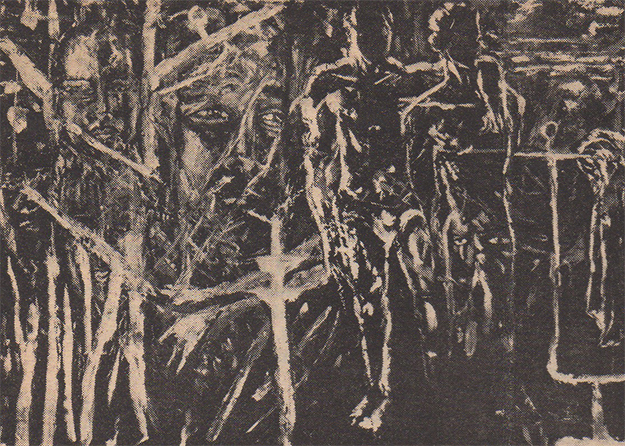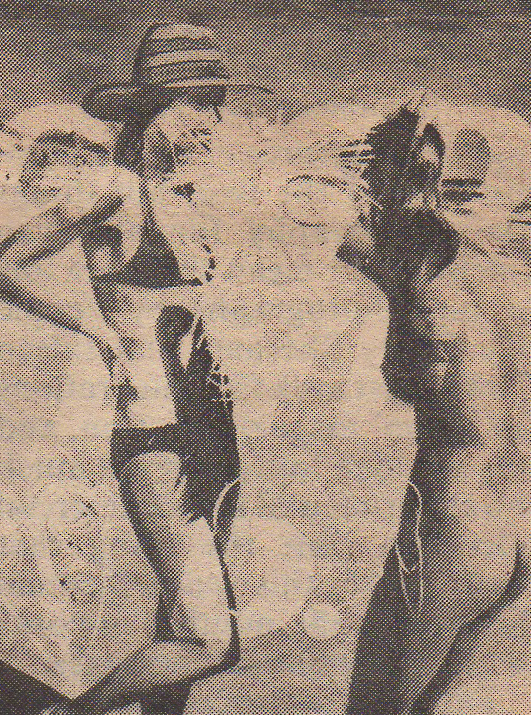
JULIAN SCHNABEL, “Homo Painting”, 1981, oil on velvet, 116 x 164 inches, from the 1983 Whitney Biennial, at the Whitney Museum, 945 Madison, through May 22.
It seems that the Lee Strasberg School of Method Acting and the black leather boot marks of James Dean and Marlon Brando have crash-landed like dandruff on the shoulders of the Young Bunch in the 1983 Whitney Biennial.
Keith Haring slam-dances into a wall of the Whitney. It is Guer-nica run through a sieve on Avenue C, a Sunday stroll in a black on white jungle. The radiant babies chok6 on leashes reined by minotaur-headed dog-gies and the nuked-out hierogly-phics strafe white space.
On the flip side of Haring’s Wall, another kind of war unfolds in Leon Golub’s massive, 10 x 14′”Interogation (II).” The canvas hangs by industrial grommets, a subtler form of tor-ture than the bigger -than-life goon squad, prodding their vic-tims with nauseating gusto. Golub is no kid, a veteran of the 1959 New Images of Man show at the Museum of Modern Art renlember that place?). So? So there’s a couple of older types in this young bunch notion and another cycle of manic figuration has captured the collective eye of bounty-hunting curators. You can roll Golub’s unstretched canvas up like an oriental rug and hide them when the com-pany comes. In Haring’s case, you call the maintenance crew and they white-wash the wall. Clever. Non-toxic, hypo-allergenic.
Keeping the honey-comb aluminum pieces on the chess board in mind, a couple of other knights spur their steeds in mirror-preening impatience David Salle’s triptvched, mix-med ia’d melange, “Poverty is No Disgrace” (Ha), hangs an Eames-style chair from the middle panel, daring the viewer to take a seat and see if the painting holds up. (Don’t bother You can’t afford it.)
A more arresting triptych to ogle (the Whitney has been turned into a cubby-holed and klieglighted corral of hermaphroditic stallions, each straining to outdo the other), is Eric Fischl’s “Inside Out.” It is a scriptwriter’s episode of “Dallas,” a rough-rider, mounted bare back under the myopically icy presence of a Breuer chair and video camera. The monitor is a bit fuzzy but the rumpled foreground fills in the details. Fischl’s perverse universe of smirking punks lifting up the skirts of their va-va-voom siblings, is corruptingly outrage-ous. In another work, “The Old Man’s Boat and the Old Man’s Dog,” tongue-in-cheeks Wins-low Homer’s “Gulf Stream” but in a skipperless Love Boat. A wagging Dalmatian sniffs some nubile flesh on a sun-baked cushion while a monstrous, lapis-lazuli wave dreamily zeroes in for the kill.
With all the oompah of dramatic installations–from Jona-than Borofsky’s barefooted and pony-tailed superman (“Man in Space II”) to Mike Glier’s mushroom-clouded d,ayd ream over an empty plate (“Nuclear Accountability: I Blast Me”)–an appropriate Ferrante & Teicher soundtrack is sorely missed. The sun-drenched chirpings and moanful violin strings emanating from Mary Lucier’s monotonously—monitored “Ohio at Giverny” is from the wrong century The Biennial needs the anti-phonic racket of a Glenn Branca to bruise the visitor’s eardrum as well as eyeball, as so effortlessly demonstrated by William Wiley, a brown-speckled egg sandwiched in an Easter Basket of otherwise white ones.
This duplex salon of cham-pions has a funny way of arrang-ing furniture. In the Angst Room, Julian Schnabel’s smarmy oil on red velvet, “What to do with a Corner in Madrid” (Condemn It?) glares at Susan Rothenberg’s cream-cheese-blottered “10 Men.” Down the hall in the Stand-Up Comics’ chamber, R.M. Fisher’s gutter snipe pop lamp sculptures illuminated a carpeted corner, a stogy away from Robert Colescott’s “Listening to Amos and Andy,” but downwind from Mark Tansey’s headbutting canvas.

DAVID SALLE, “Good Bye D.,” 1982, acrylic on canvas, 112 x 86 inches, from the 1983 Whit-ney Biennial, at the Whitney Museum, 945 Madison Ave., through May 22.
This time around, the Biennial aquarium of blowfish gets a smaller tank (due to the permanent collection on the third floor with works from the first Biennial in 1932) and a number of annoying, that is, abstract forms have been weeded out. A high strung sampler of regional porgies from outlying lakes fill in the main courses, like an unfamiliar bowl of sharksfin soup. Just as in the signature rump on a pair of Gloria Vanderbilt jeans, the crushingly familiar images blink their neon logos: Longo showes us the bratty offsprings of television commercials and Jenny Holzer–the Walter of Lippmann „of the Gloom & Doom set snarls, “Don’t Talk Down to Me.”
With all of its sledge-hammer editing the Biennial limelights a forgotten titan, Joan Mitchell, and throws in-for good measure?–an amputated arm from Jasper John’s steamer
trunk